2019 Hyundai Tucson length
[x] Cancel search: lengthPage 48 of 685
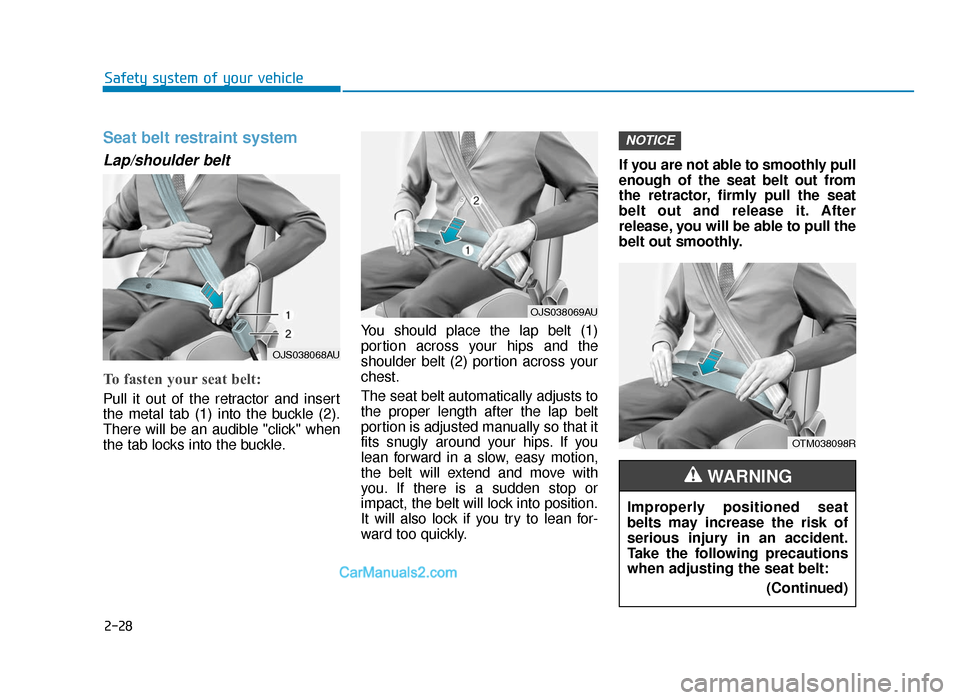
2-28
Safety system of your vehicle
Seat belt restraint system
Lap/shoulder belt
To fasten your seat belt:
Pull it out of the retractor and insert
the metal tab (1) into the buckle (2).
There will be an audible "click" when
the tab locks into the buckle.You should place the lap belt (1)
portion across your hips and the
shoulder belt (2) portion across your
chest.
The seat belt automatically adjusts to
the proper length after the lap belt
portion is adjusted manually so that it
fits snugly around your hips. If you
lean forward in a slow, easy motion,
the belt will extend and move with
you. If there is a sudden stop or
impact, the belt will lock into position.
It will also lock if you try to lean for-
ward too quickly.If you are not able to smoothly pull
enough of the seat belt out from
the retractor, firmly pull the seat
belt out and release it. After
release, you will be able to pull the
belt out smoothly.
NOTICE
OJS038068AU
OTM038098R
Improperly positioned seat
belts may increase the risk of
serious injury in an accident.
Take the following precautions
when adjusting the seat belt:
(Continued)
WARNING
OJS038069AU
TLe UK 2.qxp 6/12/2018 2:06 PM Page 28
Page 275 of 685
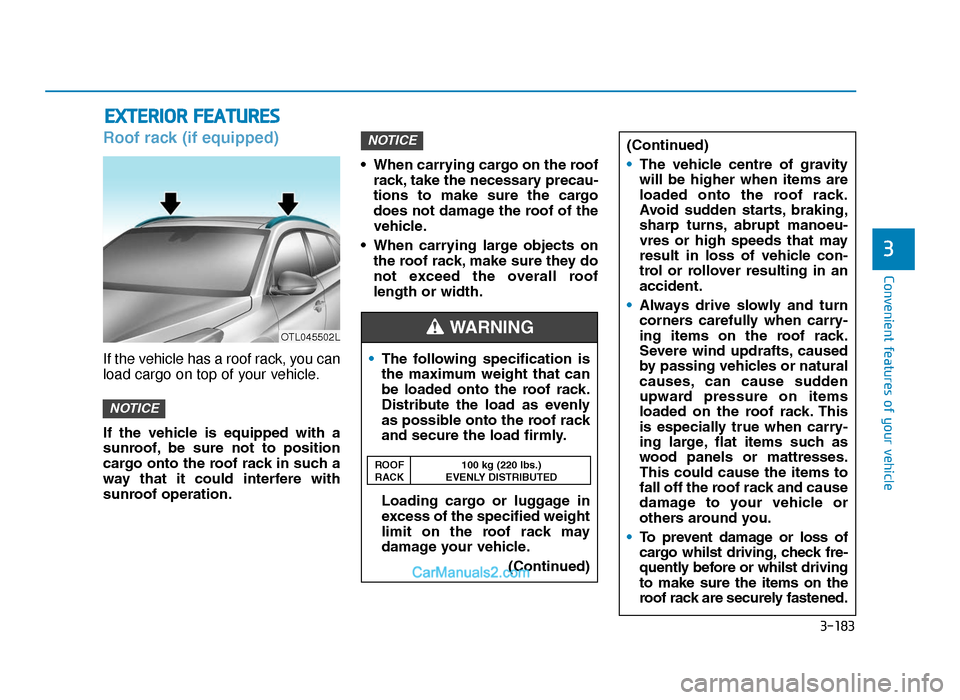
3-183
Convenient features of your vehicle
3
Roof rack (if equipped)
If the vehicle has a roof rack, you can
load cargo on top of your vehicle.
If the vehicle is equipped with a
sunroof, be sure not to position
cargo onto the roof rack in such a
way that it could interfere with
sunroof operation.• When carrying cargo on the roof
rack, take the necessary precau-
tions to make sure the cargo
does not damage the roof of the
vehicle.
• When carrying large objects on the roof rack, make sure they do
not exceed the overall roof
length or width.
NOTICE
NOTICE
EXTERIOR FEATURES
OTL045502L
•The following specification is
the maximum weight that can
be loaded onto the roof rack.
Distribute the load as evenly
as possible onto the roof rack
and secure the load firmly.
Loading cargo or luggage in
excess of the specified weight
limit on the roof rack may
damage your vehicle.
(Continued)
WARNING
ROOF100 kg (220 lbs.)
RACK EVENLY DISTRIBUTED
(Continued)
• The vehicle centre of gravity
will be higher when items are
loaded onto the roof rack.
Avoid sudden starts, braking,
sharp turns, abrupt manoeu-
vres or high speeds that may
result in loss of vehicle con-
trol or rollover resulting in an
accident.
• Always drive slowly and turn
corners carefully when carry-
ing items on the roof rack.
Severe wind updrafts, caused
by passing vehicles or natural
causes, can cause sudden
upward pressure on items
loaded on the roof rack. This
is especially true when carry-
ing large, flat items such as
wood panels or mattresses.
This could cause the items to
fall off the roof rack and cause
damage to your vehicle or
others around you.
• To prevent damage or loss of
cargo whilst driving, check fre-
quently before or whilst driving
to make sure the items on the
roof rack are securely fastened.
TLe UK 3b(110~).qxp 6/12/2018 2:42 PM Page 183
Page 305 of 685

4-30
Multimedia System
Notes on connecting Apple devices
• Ensure that the iOS and firmwareof your device is up-to-date before
connecting it to your system.
Outdated devices may cause a
system error.
• If your device’s battery is low, the device may not be recognised.
Check the battery level and, if nec-
essary, charge the battery before
connecting the device to your sys-
tem.
• Use an Apple-approved cable. Using an unapproved cable may
cause a distorted noise or an error
during playback.
• Use a cable shorter than 1 metre in length, such as the one originally
supplied with a new Apple device.
Longer cables may lead to the
audio system not recognising the
Apple device.
• Fully insert a USB connector into the USB port. Failure to do so may
cause a communication error. • When your device is connected to
the USB port and the AUX port
simultaneously, it is recognised in
the AUX mode. The device stays in
the AUX mode even if the AUX
cable is not connected to the sys-
tem. To play music in iPod mode,
disconnect the AUX cable from the
device or change audio output of
the device to “Dock”.
• If you connect your device to the system whilst playback is in
progress on the device, you may
hear a high pitch sound just after
the connection. Connect the device
after stopping or pausing playback.
• Connecting your device during a download or synchronizing with
iTunes may cause an error.
Connect the device after the down-
load or synchronization is com-
plete.
• If you connect an iPod nano (except for the 6th generation) or
an iPod classic, the brand logo will
be displayed on the device screen.
For an iPhone and an iPod touch,
the logo will not be displayed.
Notes on playing Apple devices
• Depending on the model, yourdevice may not be recognised due
to unsupported communication
protocols.
• The order of the songs displayed or played on the system may differ
from the order of the songs stored
in your device.
• Depending on the music player application you are using, informa-
tion displayed on the system may
differ.
• In an iPhone, the audio streaming function and iPod mode control
may conflict. If an error occurs, dis-
connect and reconnect the USB
cable.
• When using an iPhone or an iPod touch, do not control the device
whilst it is connected to your sys-
tem. An error may occur.
• If you make or receive a call during playback via an iPhone, the music
may remain paused after you end
the call. If you do not hear the
music after ending a call, check the
device to see if the music is
paused.
TLe UK 4.qxp 5/10/2018 12:05 PM Page 30
Page 321 of 685
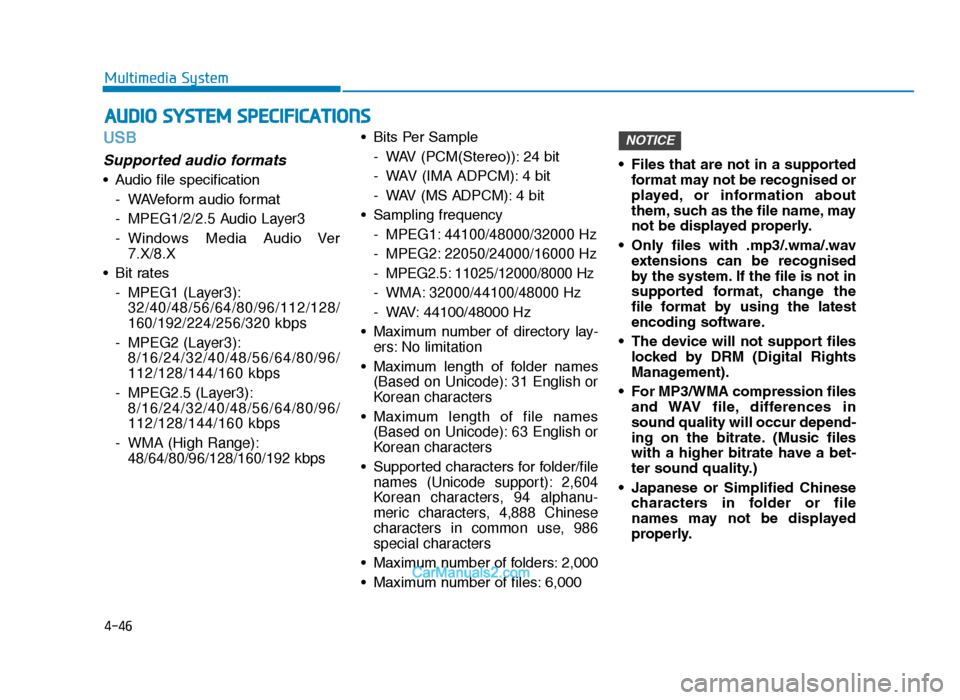
4-46
Multimedia System
USB
Supported audio formats
• Audio file specification- WAVeform audio format
- MPEG1/2/2.5 Audio Layer3
- Windows Media Audio Ver7.X/8.X
• Bit rates - MPEG1 (Layer3):32/40/48/56/64/80/96/112/128/
160/192/224/256/320 kbps
- MPEG2 (Layer3): 8/16/24/32/40/48/56/64/80/96/
112/128/144/160 kbps
- MPEG2.5 (Layer3): 8/16/24/32/40/48/56/64/80/96/
112/128/144/160 kbps
- WMA (High Range): 48/64/80/96/128/160/192 kbps • Bits Per Sample
- WAV (PCM(Stereo)): 24 bit
- WAV (IMA ADPCM): 4 bit
- WAV (MS ADPCM): 4 bit
• Sampling frequency - MPEG1: 44100/48000/32000 Hz
- MPEG2: 22050/24000/16000 Hz
- MPEG2.5: 11025/12000/8000 Hz
- WMA: 32000/44100/48000 Hz
- WAV: 44100/48000 Hz
• Maximum number of directory lay- ers: No limitation
• Maximum length of folder names (Based on Unicode): 31 English or
Korean characters
• Maximum length of file names (Based on Unicode): 63 English or
Korean characters
• Supported characters for folder/file names (Unicode support): 2,604
Korean characters, 94 alphanu-
meric characters, 4,888 Chinese
characters in common use, 986
special characters
• Maximum number of folders: 2,000
• Maximum number of files: 6,000 • Files that are not in a supported
format may not be recognised or
played, or information about
them, such as the file name, may
not be displayed properly.
• Only files with .mp3/.wma/.wav extensions can be recognised
by the system. If the file is not in
supported format, change the
file format by using the latest
encoding software.
• The device will not support files locked by DRM (Digital Rights
Management).
• For MP3/WMA compression files and WAV file, differences in
sound quality will occur depend-
ing on the bitrate. (Music files
with a higher bitrate have a bet-
ter sound quality.)
• Japanese or Simplified Chinese characters in folder or file
names may not be displayed
properly.
NOTICE
AUDIO SYSTEM SPECIFICATIONS
TLe UK 4.qxp 5/10/2018 12:05 PM Page 46
Page 408 of 685
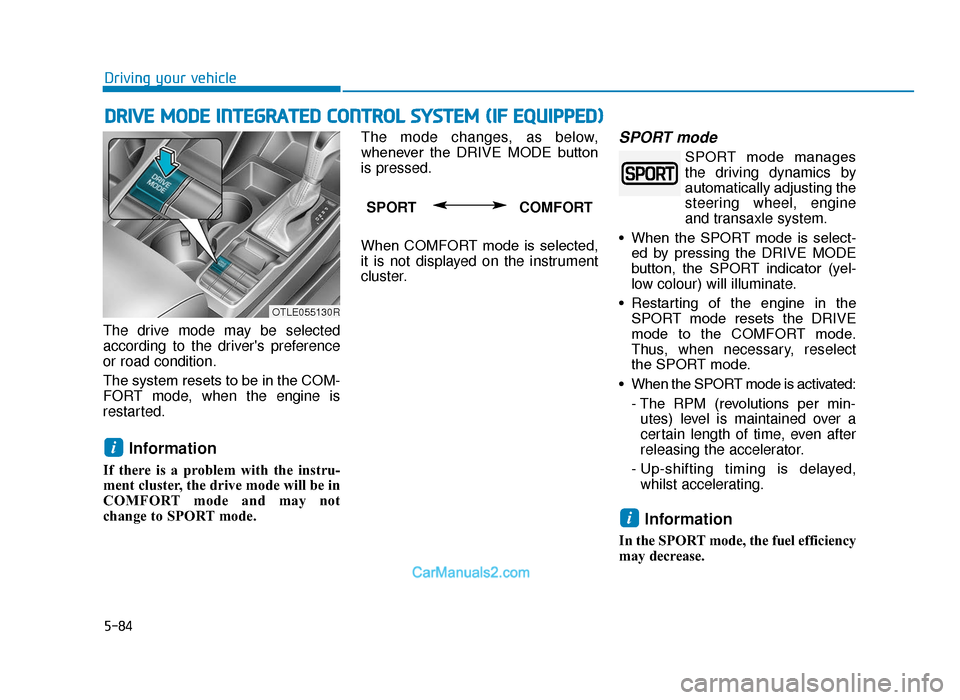
5-84
Driving your vehicle
DRIVE MODE INTEGRATED CONTROL SYSTEM (IF EQUIPPED)
The drive mode may be selected
according to the driver's preference
or road condition.
The system resets to be in the COM-
FORT mode, when the engine is
restarted.
Information
If there is a problem with the instru-
ment cluster, the drive mode will be in
COMFORT mode and may not
change to SPORT mode. The mode changes, as below,
whenever the DRIVE MODE button
is pressed.
When COMFORT mode is selected,
it is not displayed on the instrument
cluster.
SPORT mode
SPORT mode manages
the driving dynamics by
automatically adjusting the
steering wheel, engine
and transaxle system.
• When the SPORT mode is select- ed by pressing the DRIVE MODE
button, the SPORT indicator (yel-
low colour) will illuminate.
• Restarting of the engine in the SPORT mode resets the DRIVE
mode to the COMFORT mode.
Thus, when necessary, reselect
the SPORT mode.
• When the SPORT mode is activated: - The RPM (revolutions per min-utes) level is maintained over a
certain length of time, even after
releasing the accelerator.
- Up-shifting timing is delayed, whilst accelerating.
Information
In the SPORT mode, the fuel efficiency
may decrease.
i
i
SPORT COMFORT
OTLE055130R
TLe UK 5.qxp 5/10/2018 12:24 PM Page 84
Page 498 of 685
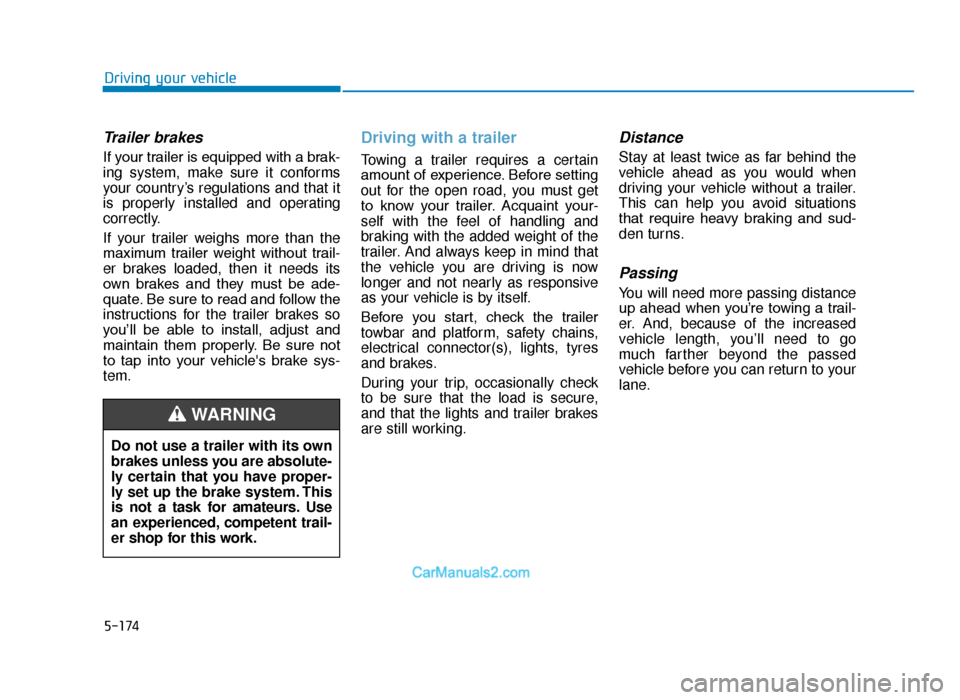
5-174
Driving your vehicle
Trailer brakes
If your trailer is equipped with a brak-
ing system, make sure it conforms
your country’s regulations and that it
is properly installed and operating
correctly.
If your trailer weighs more than the
maximum trailer weight without trail-
er brakes loaded, then it needs its
own brakes and they must be ade-
quate. Be sure to read and follow the
instructions for the trailer brakes so
you’ll be able to install, adjust and
maintain them properly. Be sure not
to tap into your vehicle's brake sys-
tem.
Driving with a trailer
Towing a trailer requires a certain
amount of experience. Before setting
out for the open road, you must get
to know your trailer. Acquaint your-
self with the feel of handling and
braking with the added weight of the
trailer. And always keep in mind that
the vehicle you are driving is now
longer and not nearly as responsive
as your vehicle is by itself.
Before you start, check the trailer
towbar and platform, safety chains,
electrical connector(s), lights, tyres
and brakes.
During your trip, occasionally check
to be sure that the load is secure,
and that the lights and trailer brakes
are still working.
Distance
Stay at least twice as far behind the
vehicle ahead as you would when
driving your vehicle without a trailer.
This can help you avoid situations
that require heavy braking and sud-
den turns.
Passing
You will need more passing distance
up ahead when you’re towing a trail-
er. And, because of the increased
vehicle length, you’ll need to go
much farther beyond the passed
vehicle before you can return to your
lane.
Do not use a trailer with its own
brakes unless you are absolute-
ly certain that you have proper-
ly set up the brake system. This
is not a task for amateurs. Use
an experienced, competent trail-
er shop for this work.
WARNING
TLe UK 5.qxp 5/10/2018 12:32 PM Page 174
Page 652 of 685
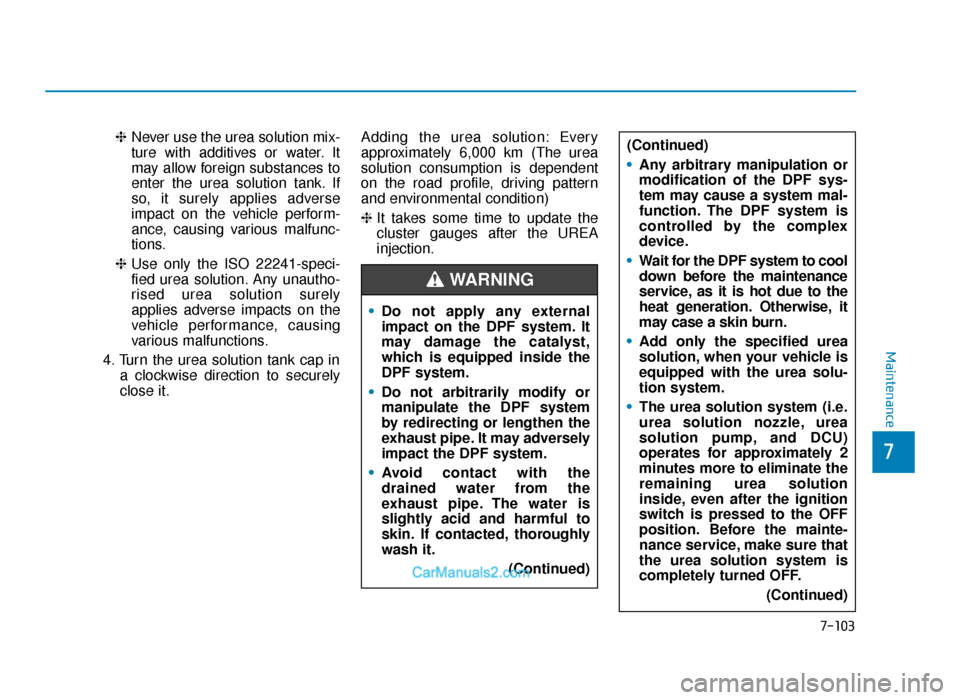
❈Never use the urea solution mix-
ture with additives or water. It
may allow foreign substances to
enter the urea solution tank. If
so, it surely applies adverse
impact on the vehicle perform-
ance, causing various malfunc-
tions.
❈ Use only the ISO 22241-speci-
fied urea solution. Any unautho-
rised urea solution surely
applies adverse impacts on the
vehicle performance, causing
various malfunctions.
4. Turn the urea solution tank cap in a clockwise direction to securely
close it. Adding the urea solution: Every
approximately 6,000 km (The urea
solution consumption is dependent
on the road profile, driving pattern
and environmental condition)
❈
It takes some time to update the
cluster gauges after the UREA
injection.
7-103
7
Maintenance
•Do not apply any external
impact on the DPF system. It
may damage the catalyst,
which is equipped inside the
DPF system.
• Do not arbitrarily modify or
manipulate the DPF system
by redirecting or lengthen the
exhaust pipe. It may adversely
impact the DPF system.
• Avoid contact with the
drained water from the
exhaust pipe. The water is
slightly acid and harmful to
skin. If contacted, thoroughly
wash it.
(Continued)
WARNING
(Continued)
•Any arbitrary manipulation or
modification of the DPF sys-
tem may cause a system mal-
function. The DPF system is
controlled by the complex
device.
• Wait for the DPF system to cool
down before the maintenance
service, as it is hot due to the
heat generation. Otherwise, it
may case a skin burn.
• Add only the specified urea
solution, when your vehicle is
equipped with the urea solu-
tion system.
• The urea solution system (i.e.
urea solution nozzle, urea
solution pump, and DCU)
operates for approximately 2
minutes more to eliminate the
remaining urea solution
inside, even after the ignition
switch is pressed to the OFF
position. Before the mainte-
nance service, make sure that
the urea solution system is
completely turned OFF.
(Continued)
TLe UK 7.qxp 6/12/2018 2:51 PM Page 103
Page 658 of 685
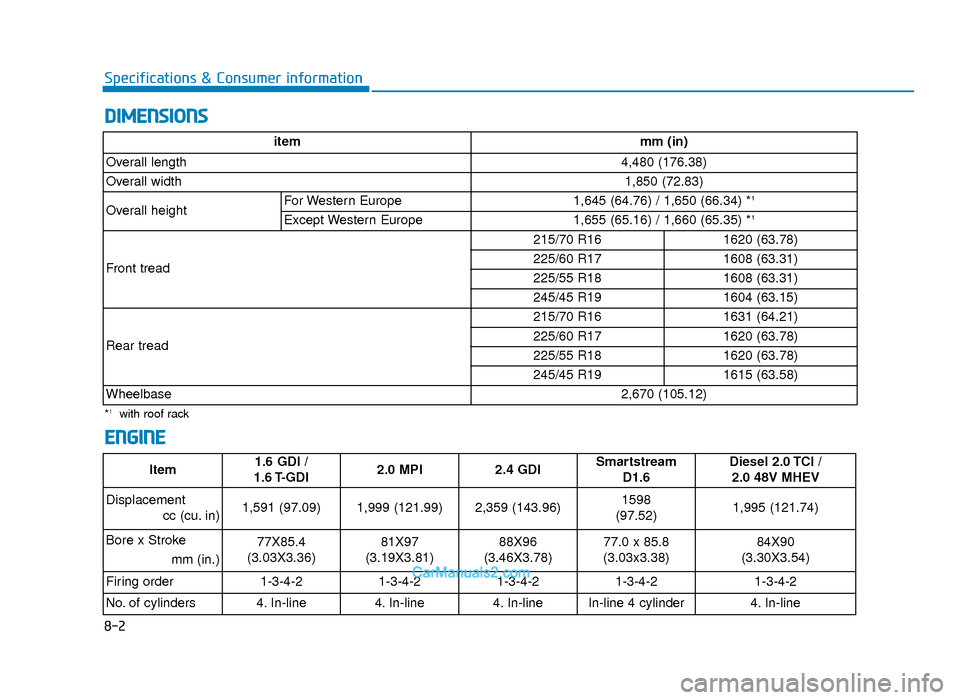
8-2
Specifications & Consumer information
DIMENSIONS
ENGINE
itemmm (in)
Overall length 4,480 (176.38)
Overall width 1,850 (72.83)
Overall height For Western Europe
1,645 (64.76) / 1,650 (66.34) *
1
Except Western Europe1,655 (65.16) / 1,660 (65.35) *1
Front tread 215/70 R16
1620 (63.78)
225/60 R17 1608 (63.31)
225/55 R18 1608 (63.31)
245/45 R19 1604 (63.15)
Rear tread 215/70 R16
1631 (64.21)
225/60 R17 1620 (63.78)
225/55 R18 1620 (63.78)
245/45 R19 1615 (63.58)
Wheelbase 2,670 (105.12)
*1with roof rack
Item1.6 GDI /
1.6 T-GDI 2.0 MPI2.4 GDI Smartstream D1.6Diesel 2.0 TCI / 2.0 48V MHEV
Displacement cc (cu. in)
1,591 (97.09)1,999 (121.99)2,359 (143.96)1598
(97.52)1,995 (121.74)
Bore x Stroke mm (in.)
77X85.4
(3.03X3.36)81X97
(3.19X3.81)88X96
(3.46X3.78)77.0 x 85.8
(3.03x3.38)84X90
(3.30X3.54)
Firing order
1-3-4-21-3-4-21-3-4-21-3-4-21-3-4-2
No. of cylinders
4. In-line4. In-line4. In-lineIn-line 4 cylinder4. In-line
TLe UK 8.qxp 6/12/2018 3:17 PM Page 2